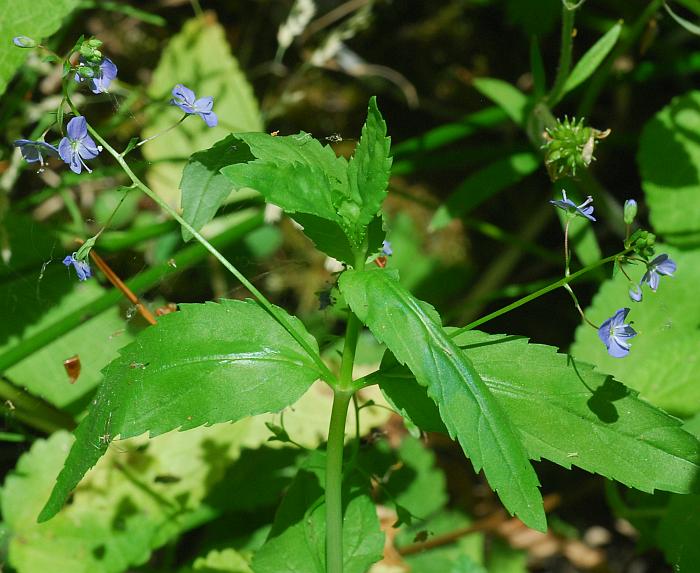Veronica americana Schwein. ex Benth.
American Brooklime

Native
CC = 10
CW = -5
MOC = 1
© SRTurner
Veronica americana Schwein. ex Benth.American Brooklime | |
 |
Native CC = 10 CW = -5 MOC = 1 |
© SRTurner |
|
Family - Plantaginaceae Habit - Rhizomatous perennial forb. Stem - Ascending to erect, to 100 cm, usually only a short basal portion spreading (occasionally plants flattened by flooding may have a more spreading growth form), glabrous.
Leaves - Alternate, simple, petiolate. Blades 1.5-5.0 cm long, mostly 2-4 times as long as wide, lanceolate to narrowly ovate or triangular-ovate (the lowermost occasionally elliptic to elliptic-ovate), mostly broadest toward the base, bluntly to sharply pointed at the tip, rounded to truncate or shallowly cordate at the base, not clasping the stems, the margins unlobed, flat, finely and bluntly to more commonly sharply toothed (those of the lowermost leaves sometimes subentire), the surfaces glabrous.
Inflorescences - Axillary racemes, these usually in opposite pairs at the stem nodes (1 per leaf), open at maturity, with 10-25 flowers, the bracts 2-6 mm long, much smaller than the foliage leaves, linear to narrowly lanceolate. Flower stalks 5-10 mm long at flowering (to 15 mm long at fruiting), ascending at flowering, but mostly spreading at a right angle to the axis at fruiting.
Flowers - Calyces 2.5-5.0 mm long, the lobes slightly unequal, the upper 2 lobes slightly shorter than the lower 2 lobes, deeply 4-lobed, the lobes lanceolate or oblong-oblanceolate to ovate or oblong-obovate, glabrous. Corollas 5-10 mm wide, blue to purplish blue with darker veins, the throat white or sometimes pale greenish-tinged at the base, the lobes spreading to loosely cupped upward. Style 2.0-3.5 mm long at fruiting.
Fruits - Capsules 2.5-3.5 mm long, mostly slightly wider than long, depressed-obovate to more or less circular in profile, somewhat turgid, the notch very shallow, the surfaces and margins glabrous, usually dehiscing both along and between the sutures into 4 valves. Seeds numerous, 0.4-0.7 mm long, strongly flattened on one side and somewhat convex on the other, the surfaces appearing smooth or slightly pebbled, light brown to brown.
Flowering - June - August. Habitat - Spring branches, streambanks. Origin - Native to the U.S. Lookalikes - Other large species of Veronica, especially V. beccabunga, V. catenata and V. anagallis-arvensis. Other info. - This plant is one of a few Missouri members of its genus having axillary racemes of flowers and a generally larger aspect than the small, weedy species. This branch of the genus is much less common than the small, weedy species. V. americana is apparently especially rare in Missouri, having been collected from only one or two counties and never in recent years. It is identified by its axillary racemes of flowers and distinctly petiolate leaves, which are usually toothed. Due to the plant's rarity in Missouri, its local habitat preferences are not precisely known, but are certain to include abundant moisture. The species is much more common in the western half of the continental U.S., and also the Northeast and Canada. Photographs taken on Anderson Island, Pierce County, WA, 6-16-2015, and at Woodson K. Woods Conservation Area, Crawford County, MO, 9-17-2021 (SRTurner). |